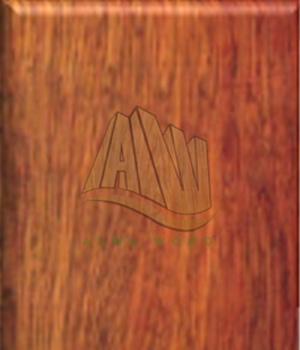NATURAL DURABILITY
Kulim is classified as moderately durable under Malaysian conditions. This rating is based on the standard graveyard test of untreated
specimens of dimensions 50 mm x 50 mm x 600 mm conducted at the Forest Research Institute Malaysia (FRIM). In the test, 60 specimens were used and the average
service life was found to be 4 years (Jackson, 1965).
Kulim is immune to powder post beetle attacks (Menon, 1958) but not to ambrosia beetles (Desch, 1941). Attack by termites does not appear to be severe.
The main cause of destruction of the timber is rot. The timber is also immune to marine borers. Trials at Port Klang indicate that it is not greatly inferior
to belian. Untreated specimens of 13 x 13 cm (5 x 5 in) and 13 x 26 cm (5 x 10 in) remained serviceable for 2 to 3 and 4 to 5 years respectively, while treated
specimens (13 x 13 cm, treated by open tank method to 107 kg/m3 absorption of 50/50 creosote and diesel fuel, and 13 x 26 cm treated to 107 kg/m3 absorption by a
full-cell process) had a service life of 3 and 5 years respectively (Walter, 1941). From these figures, it is expected that 30 x 30 cm (12 x 12 in) untreated piles
may have a service life of 7 to 10 years.
PRESERVATIVE TREATMENT
Kulim is classified as average in the amenability classification.
TEXTURE
Texture is fine to moderately coarse and even, with deeply interlocked and sometimes wavy grain.
STRENGTH PROPERTIES
The timber falls into Strength Group B (Engku, 1988b) or SG 3 (MS 544:Part 2:2001).
Strength Properties of Kulim
| Test Condition |
Modulus of Elasticity(MPa) |
Modulus of Rupture(MPa) |
Compression parallel to grain (MPa) |
Compression perpendicular to grain (MPa) |
Shear strength(MPa) |
| Green |
13,300 |
78 |
44.4 |
4.48 |
8.8 |
| Air dry |
14,900 |
107 |
57.0 |
5.10 |
10.3 |
MACHINING PROPERTIES
It is slightly difficult to difficult to resaw and is easy to slightly difficult to cross-cut. The air dried material is slightly difficult to
plane but the quality of finish is smooth.
Machining Properties of Keranji
| Test Condition |
Sawing |
Planning |
Boring |
Turning |
|
Re Sawing |
Cross Cutting |
Ease of planing |
Quality of finish |
Ease of boring |
Quality of finish |
Ease of Turning |
Quality of finish |
| Green |
Slightly difficult |
Easy |
Easy |
Smooth |
Easy |
Smooth |
- |
- |
| Air dry |
Difficult |
Slightly difficult |
Slightly difficult |
Smooth |
Slightly difficult |
Smooth |
Moderate Easy |
Slightly Rough |
Nailing Property
The nailing property is rated as very poor.
Air drying
The timber seasons fairly rapidly, with moderate end-checking and splitting and slight surface-checking as the main sources of degrade.
13 mm thick boards take 2 months to air dry, while 38 mm thick boards take 4 months.
Kiln-Drying
Kiln Schedule E is recommended. The timber is prone to surface-checking and end-splitting. 25 mm thick boards take approximately 10 days to kiln-dry
from 50 to 10% moisture content.
SHRINKAGE
Shrinkage is fairly high, with radial shrinkage averaging 1.7% and tangential shrinkage averaging 3.2%.
DEFECTS
The logs are generally free from defects except for the core which is often defective.
Uses
The timber is suitable for medium construction under cover, posts, beams, joists, rafters, door and window frames and sills, bridges and tool handles (impact).
The timber possesses a certain degree of resistance to marine borers and may be used in the marine environment. The timber is also suitable for ship and boat building
(keels, keelsons and framework), flooring, railway sleepers, cooling towers (structural members), columns (light duty) and telegraphic and power transmission posts and
cross arms when treated with preservatives.
REFERENCES
Abd. Rashid b. Hj. A. Malik. 1983. Malaysian Timbers - Kulim. Malaysian Forest Service Trade Leaflet No.77. The Malaysian Timber Industry Board and Forest Research
Institute Malaysia, Kuala Lumpur. 5 pp.
Desch, H.E.1941. Manual of Malayan Timbers. Mal.For.Rec.No.15 Vol.1.
Engku Abdul Rahman Chik. 1998b. Basic and Grade Stresses for Strength Groups of Malaysian Timbers. Malayan Forest ServiceTrade Leaflet No. 38.
The Malaysian Timber Industry Board and Forest Research Institute Malaysia, Kuala Lumpur. 13 pp
Jackson, W.F.1965. The Durability of Malayan Timbers. Mal.For.Ser.Trade Leaflet No.28.
Menon, K.D.1958. Susceptibility of Malayan Timbers to Powder-post Beetle. Mal.For.Ser.Trade Leaflet No.27.
Menon, P.K.B.1986. Uses of Some Malaysian Timbers. Revised by Lim, S.C. Timber Trade Leaflet No.31. The Malaysian Timber Industry Board and Forest Research
Institute Malaysia, Kuala Lumpur.48 pp.
MS 544:Part 2:2001. Code of Practice for the Structural Use of Timber: Permissible Stress Design of Solid Timber.
Walter, F.S.1941. Resistance of Timbers of Marine Borer Attack. Mal. For. X:145.
Wong, T.M.1982. A Dictionary of Malaysian Timbers. Revised by Lim, S.C. & Chung, R.C.K. Malayan Forest Records No.30. Forest Research Institute Malaysia, Kuala Lumpur.
201 pp.

